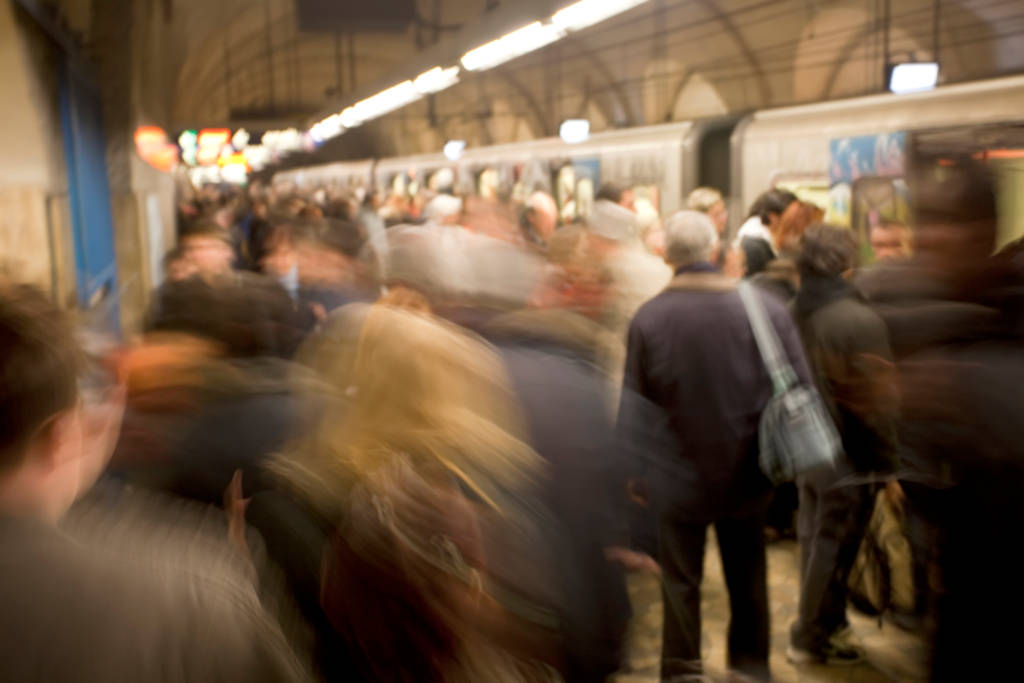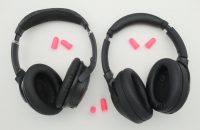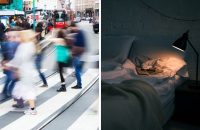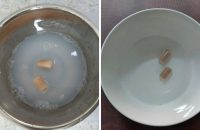
This article looks at when and how active noise cancelling headphones (=headphones that use electronics to reduce noise) can help to protect your hearing.
Used correctly, good noise cancelling headphones have the potential to protect hearing in many situations, but they are not safety earmuffs.
And, they can also damage your hearing if you play music at an excessive volume.
Contents
Hearing damage through loud music is increasing. With noise cancelling headphones you can play sound at a lower volume
Excessively loud music is a major cause of hearing loss.
If you are listening to music or audiobooks at a normal volume in a loud coffee shop or office, an airplane, or on the subway, your music gets partially or even completely masked (=drowned out) by environmental noise.
So what do you do? You increase the volume to better hear the music. With powerful headphones it is very easy to exceed a safe sound level and over time you damage your hearing.
Now, with good noise cancelling headphones you can significantly reduce the amount of environmental noise reaching your ears.
Active noise cancelling is very effective against low frequency noise.
As it turns out, it is easier for lower frequencies to drown out the higher frequencies in your music or audiobook than for higher frequencies to mask lower frequencies.
Modern cities, airplane cabins, subway cars, and even many offices and coffee shops are full of low frequency noise from engines, HVAC systems, generators, etc.
By preventing these low frequencies from reaching your ears, active noise cancelling headphones make it easier to hear your music and audiobooks at a lower volume.
In addition, state-of-the-art noise cancelling headphones have good ear cups that passively reduce mid and high frequency noise, so they are also over-the-ear noise isolating headphones.
Overall, when using good active noise cancelling headphones you hear less environmental noise and can listen at a substantially lower volume.
Are they the only device that can do that?
No, if you are willing to plug your ears, passive noise-isolating in-ear earphones are very effective and sound good as well.
Safety earmuffs with built-in headphones also do a very good job at blocking noise, but they are not nearly as comfortable and don’t sound as good.
Ii is the unique combination of wearing comfort, excellent low-frequency noise reduction, and good sound quality that have made ANC headphones such a popular choice.
Noise cancelling headphones can help to reduce the daily noise onslaught

Is 85 decibels the recommended limit?
Many people believe 85 decibels (dBA) is the magical number when it comes to determining whether a place is too loud.
But, these 85 decibels are actually meant by NIOSH as a recommended 8-hour (time-weighted average) occupational noise exposure limit and not an environmental noise exposure limit.
Nevertheless, in Understanding Noise Exposure Limits: Occupational vs. General Environmental Noise, NIOSH also states the following:
“… while the NIOSH REL only applies to the workplace, protecting your hearing whenever sounds reach 85 dB(A) or more is a good health practice no matter where your ears are!”
Depending on where you sit, noise levels in airplane cabins and on public transport can exceed 85 dBA for periods of time.
In 2009, an extensive study was done on noise levels associated with New York City’s Mass Transit System.
“MTA subways had the highest maximum noise levels on average (90.4 dBA). The highest Lmax level among all platform measurements was at an MTA subway station (102.1 dBA), followed closely by a bus stop measurement (101.6 dBA).”
Mean noise levels were quite a bit lot lower, but high enough for the researchers to conclude:
“Mass transit noise exposure has the potential to exceed limits recommended by the World Health Organization and the US Environmental Protection Agency and thus cause noise-induced hearing loss among riders of all forms of mass transit given sufficient exposure durations.”
Recommended environmental noise exposure limits are lower than occupational noise limits
In What noise level is safe for preventing hearing loss, referring to a 70 dB (average over 24 hours) EPA recommendation (not a standard or regulation), Dr. Daniel Fink comes to the following conclusion:
“The occupational noise exposure standard of 85 db is not appropriate outside the workplace. The much lower 70 dB average noise exposure level is the only published safe noise level to protect the public’s hearing.”
It is important to note that the 70 dB are meant as an average, which is actually already pretty high.
(Imagine having a vacuum cleaner running 6 ft. away from you for 24 hours.)
On the other hand, peak sound levels above 70 decibels occur even quite often in natural environments.

Still, the effects of environmental noise over the course of a human life add up.
For noise levels above 70 (and below 85) decibels, it is the constant onslaught I am concerned about for my hearing.
Note: +3 dB in sound level amounts to twice the sound energy. This exchange rate is commonly used when determining equivalent noise exposures (and based on the equal energy hypothesis): So 70 decibels for 24 hours equals 12 hours at 73 decibels and only 6 hours at 76 decibels… (This does not apply to loud impulse noise, which can be damaging in an instant.)
To understand whether you have exceeded 70 dB on average during a given day, you would have to account for how long you were exposed to which noise level and calculate a time-weighted average.
(A noise dosimeter could actually do that for you.)
Many public places, including louder restaurants and coffee shops and gyms exceed 70 decibels for periods of time.
Then you spend time on public transport, walk along busy roads and endure the construction that is going on next door. Finally, you listen to louder music for an hour or two…
Now I am not suggesting that you shouldn’t go the coffee shop, the mall, or the train station.
I go there as well. I love the vibrancy of these places and I mostly enjoy being in the city.
And I like my music as much as the next person.
But simply by wearing noise cancelling headphones (or earplugs or light earmuffs) when you feel it’s appropriate, you can reduce your noise exposure over the course of a day.
Please also read Do Noise Cancelling Headphones Work without Music for more information, in particular on low frequency noise.
Not all noise cancelling headphones are created equal
What you have to watch out for when looking for noise cancelling headphones, is that the effectiveness among different models varies widely. To some degree, this also applies to their passive noise isolation, in particular when comparing in-ear and over-the-ear models.
Hearing protection earmuffs and earplugs are tested following a specific standard and given a noise reduction rating (NRR).
Unfortunately, for consumer noise cancelling headphones you won’t find such a number.
Instead, you have to rely on reviewer tests and recommendations. Here are mine:
Currently I mainly use and recommend the Bose QC35 and the Sony WH1000XM3 headphones. I have worn them in many different environments (airplanes, buses, subway, office, coffee shops, outside etc.)
Both significantly cancel low frequency noise and through their ear cups also muffle mid and high frequency noise.
Over time, I have found that the WH1000XM3 reduce noise noticeably better; against bass noise, depending on the frequency, I would say they work 10 to 20% better. Sony’s ear cups also muffle somewhat more mid-frequency noise. In terms of noise reduction, at this point, I don’t know of any better ones.
To this day, I still use the QC35 more often though. I prefer their sound and ease-of-use (e.g., they can connect to two phones or a phone and a computer at the same time) and their noise cancelling ability is very good. They work just fine.
I find both headphones comfortable (the Bose perhaps a tad more so).
Should you use noise cancelling headphones as a hearing protector in an occupational setting or at the drag race?
As mentioned earlier, the performance among active noise cancelling headphones varies widely. On one hand, you have ANC headphones that offer at best 5 decibels noise reduction at some lower frequencies and very modest passive noise isolation.
On the other hand you have excellent noise cancelling headphones like the Sony WH1000XM3 that offer great noise cancellation and good noise isolation.
Some people report that they use noise cancelling headphones to protect their hearing in a machine shop or when riding a gas-powered lawn mower while listening to music at the same time.
It may be tempting to use them, but is it a good idea? And where is the NRR?
In the U.S., as per EPA regulation, devices sold as a hearing protector have to be labeled with a noise reduction rating (NRR).
Hearing protection earmuffs and earplugs also come with a table detailing attenuation and standard deviation for octave bands ranging from 125 to 8000 Hz obtained in a lab test according to ANSI S3.19-1974. (The NRR is based on these results.)
Here is an example:

In many other countries, there are similar standards detailing how hearing protection devices have to be tested and rated.
Unfortunately, as far as I am aware, there are currently no consumer ANC headphones that have a noise reduction rating (or a single number rating [SNR] as used in Europe).
Reviewer tests and recommendations, while helpful in determining everyday noise reduction effectiveness, are no substitute for an NRR.
So at the end of the day, I don’t see how you can assess the adequacy of a particular consumer noise cancelling headphone as a hearing protector for a certain occupational hazardous noise level.
Furthermore, in most industries in the U.S., the methods an employer can use to determine the adequacy of a hearing protector are precisely regulated!
As an employer, definitely speak to OSHA/the regulatory agency responsible for your industry first, if you are considering allowing the use of consumer noise cancelling headphones.
This is what Bose had to say
During a Bose forum discussion regarding using one of their models as a hearing protector, the Bose community manager stated the following:
‘Bose doesn’t make claims about the suitability of our noise cancelling technology for industrial applications. ( or “industrial, construction, lawn mowing, welding, metal working etc.”)’
Hearing protectors with built-in headphones and an NRR
If you are looking for a hearing protector with a noise reduction rating and built-in headphones, these are available as both in-ear models and earmuffs. Most can connect to your phone via Bluetooth, they have a built-in microphone, and some also feature a radio.
Take a look at my comparative test and review of Bluetooth hearing protection earmuffs for more details on different models and strengths and weaknesses.
Do they sound as good as noise cancelling headphones? No, unfortunately not.
But, I still find music enjoyable with them, and they are very good for audiobooks.
Better safe than sorry.
That’s it for this post. I hope you have found it useful.
All the best.

![Active Noise Cancelling vs Noise Isolating Headphones [Tested] Active Noise Cancelling vs Noise Isolating Headphones [Tested]](https://noisyworld.org/wp-content/uploads/2021/09/noise-cancelling-vs-noise-isolating-headphones-200x130.jpg)




